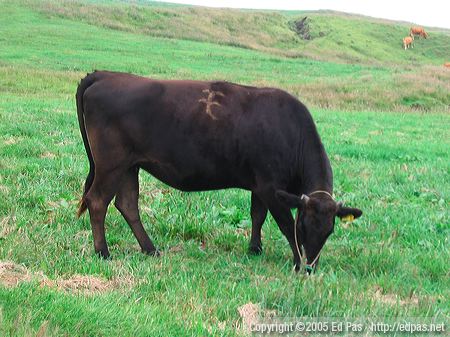The recent wave of long posts have taken their toll so I’m going to return to writing about one-part posts until I recover. But don’t worry, this condition is just a by-product of laziness and isn’t related to exposure to diseased ruminants.
Do you remember our trip to the volcano-rich Aso area of Kumamoto? If not, please read the second paragraph of my horse archery post so I don’t have to retype it.
Done with the geography refresher? Excellent. I took this picture about a third of the way up the road from the Aso Youth Hostel to the volcanic crater, back in September 2004.

The subject of this photo is a ruminant of the bovine sort. If you’re describing more than one, they’re called cattle but if you have only one, it’s necessary to figure out the gender. I’m pretty sure this one’s a “he,” or at least was at birth. I came to this conclusion based on the observation of no underside appendages, and the assumption that bulls are more likely to have their bits removed, than cows are to have udder reduction surgery. As an aside, would that be a mastectomy? Anyway, if it’s a boy, I should call him a steer, right? Alas, despite living for almost thirty years on the prairies, I still don’t have sufficient language skills to to discuss livestock in anything but the most basic terms.
Speaking of linguistics, the character on this particular steer’s side is the Japanese phonetic character mo. It sounds like that synonym for cutting the lawn. The essential stooge completing the trio of “Larry, Curly, and… .” Translated from ebonics, it means “a greater amount.” You know what I’m sayin’?
The title of today’s entry took almost as long to come up with as writing the entire rest of this post so I feel a need to demonstrate how much of a smarty pants I think I am I’d better explain. I probably don’t need to say anything about bovine but I looked it up in an online dictionary so I might as well use the definition.
Bovine. Of, relating to, or resembling a ruminant mammal of the genus Bos, such as an ox, cow, or buffalo.
The other two words are a bit more oblique. Pilic is probably an incorrect form of the Latin word pilus—plural pili—meaning “hair.” -ular is supposed to mean “having to do with.”
And achromatitis is a combination of achromatic—something thesaurus.com tells me is a synonym for bleached—and itis, a suffix which in one of the dead mediterranean languages means something like “disease.”
A cow steer with bleached hair. Rather anticlimactic, but it sums up the picture. I hope you weren’t hoping that I was going to write about an outbreak of mad cow disease. Still, I wonder what ever happened to good old-fashioned branding. It’s not like we’re dealing with Kobe beef and its massages and beer.
Where’s the picture of the “mow” ice cream that you keep buying? cows, mo, mowing grass, moo
uh oh. I think I feel a sound poem coming on . . . 😉